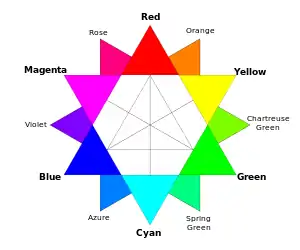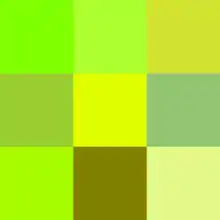Color term
A color term (or color name) is a word or phrase that refers to a specific color. The color term may refer to human perception of that color (which is affected by visual context) which is usually defined according to the Munsell color system, or to an underlying physical property (such as a specific wavelength of visible light). There are also numerical systems of color specification, referred to as color spaces.

An important distinction must be established between color and shape, as these two attributes usually are used in conjunction with one another when describing in language. For example, they are labeled as alternative parts of speech terms color term and shape term.[1]
Psychological conditions for recognition of colors exist, such as those who cannot discern colors in general or those who see colors as sound (synesthesia).
In natural languages
Monolexemic color words are composed of individual lexemes, or root words, such as 'red', 'brown', or 'olive'. Compound color words make use of adjectives (e.g. 'light brown', 'sea green') or compounded basic color words (e.g. 'yellow-green').
Color dimensions
There are many different dimensions by which color varies. For example, hue (shades of red, orange, yellow, green, blue, and purple), saturation ('deep' vs. 'pale'), and brightness or intensity make up the HSI color space. The adjective fluorescent in English refers to moderately high brightness with strong color saturation. Pastel refers to colors with high brightness and low saturation.
Some phenomena are due to related optical effects, but may or may not be described separately from the color name. These include gloss (high-gloss shades are sometimes described as 'metallic'; this is also a distinguishing feature of gold and silver), iridescence or goniochromism (angle-dependent color), dichroism (two-color surfaces), and opacity (solid vs. translucent).
Cultural differences
Different cultures have different terms for colors, and may also assign some color terms to slightly different parts of the human color space: for instance, the Chinese character 青 (pronounced qīng in Mandarin and ao in Japanese) has a meaning that covers both blue and green; blue and green are traditionally considered shades of '青'. In more contemporary terms, they are 藍 (lán, in Mandarin) and 綠 (lǜ, in Mandarin) respectively. Japanese also has two terms that refer specifically to the color green, 緑 (midori, derived from the classical Japanese descriptive verb midoru 'to be in leaf, to flourish' in reference to trees) and グリーン (guriin, which is derived from the English word 'green'). However, in Japan, although the traffic lights have the same colors that other countries have, the green light is described using the same word as for blue, aoi, because green is considered a shade of aoi; similarly, green variants of certain fruits and vegetables such as green apples, green shiso (as opposed to red apples and red shiso) will be described with the word aoi.

Similarly, languages are selective when deciding which hues are split into different colors on the basis of how light or dark they are. English splits some hues into several distinct colors according to lightness: such as red and pink or orange and brown. To English speakers, these pairs of colors, which are objectively no more different from one another than light green and dark green, are conceived of as belonging to different categories.[2] A Russian will make the same red / pink and orange / brown distinctions, but will also make a further distinction between sinii and goluboi, which English speakers would simply call dark and light blue. To Russian speakers, sinii and goluboi are as separate as red and pink, or orange and brown.[3]
Several researchers have studied the Ova-Himba perception of colors.[4] The Ova-Himba use four color names: zuzu stands for dark shades of blue, red, green, and purple; vapa is white and some shades of yellow; buru is some shades of green and blue; and dambu is some other shades of green, red, and brown. It is thought that this may increase the time it takes for the Ova-Himba to distinguish between two colors that fall under the same Herero color category, compared to people whose language separates the colors into two different color categories.[5]
Hungarian and Turkish have multiple words for 'red': piros and vörös (Hungarian; vörös is a darker red), and kırmızı, al, and kızıl (Turkish); kırmızı now includes all reds but originally referred to crimson, to which it is cognate, while kızıl mainly refers to scarlet and other orange-tinted or brownish reds. Two words for 'red' are also found in Irish and Scottish Gaelic: (dearg for light, bright red and rua or ruadh respectively for dark, brownish red). Turkish also has two words for 'white' (beyaz and ak) and 'black' (siyah and kara). Ak and beyaz have the same meaning, while kara is a broader term than siyah and also includes dark browns; which word is used also depends on the kind of object being described. Similarly, Irish uses two words for green: glas denotes the green color of plants, while uaine describes artificial greens of dyes, paints etc. This distinction is made even if two shades are identical.
In the Komi language, green is considered a shade of yellow (виж, vizh), called турун виж (turun vizh): 'grass yellow'.[6]
In the Bambara language, there are three color terms: dyema (white, beige), blema (reddish, brownish) and fima (dark green, indigo and black). In the Bassa language, there are two terms for classifying colors; ziza (white, yellow, orange and red) and hui (black, violet, blue, and green).[7]
In the Pirahã language, there appear to be no color words.[8]
Basic color terms
However, in the classic study of Brent Berlin and Paul Kay (1969), Basic Colour Terms: Their Universality and Evolution,[2] the researchers argued that these differences can be organized into a coherent hierarchy, and that there are a limited number of universal basic color terms which begin to be used by individual cultures in a relatively fixed order. Berlin and Kay based their analysis on a comparison of color words in 20 languages from around the world. To be considered a basic color term, the words had to be
- monolexemic ('green', but not 'light green' or 'forest green'),
- high-frequency, and
- agreed upon by speakers of that language.
Their model is presented below:[9]
Berlin and Kay's study further identified a culture state of color term recognition into stages numbered I-VII. Stage I only covers two terms white and black (light and dark); these terms are referenced broadly to describe other undefined color terms. For example, the Jale highland group in New Guinea identify the color of blood as black. This is because blood, as a relatively dark liquid, is grouped into the same color classification as black.
With stage II the recognition of another term, red, is developed. Objects begin to rely less on their brightness for classification and in this stage we instead see each term cover a larger scope of colors. Specifically, blue and other darker shades continue to be described as black, yellow and orange colors are classified with red, and other bright colors continue to be classified with white.
At stage III the identification of another term is acquired. The newly acquired term differs but usually refers to either green (III a) or yellow (III b). At this stage, there are more cultures who recognized yellow first, as opposed to green. Currently, there are two languages which identified green first: The Nigerian Ibiobio language and the Philippine language of Mindoro, Hanunoo.
At stage IV, whichever of the two terms (green or yellow) was not acquired at stage III is now added, bringing the total number of color terms to five.
In short, their analysis showed that in a culture with only two terms, they would roughly correlate with 'dark' (covering black, dark colors, and cold colors such as blue) and 'bright' (covering white, light colors, and warm colors such as red). All languages with three colors terms add red to this distinction. Thus, the three most basic color terms are black, white, and red. Additional color terms are added in a fixed order as a language evolves: First, one of either green or yellow; then the other; then blue. All languages distinguishing six colors contain terms for black, white, red, green, yellow, and blue. These colors roughly correspond to the sensitivities of the retinal ganglion cells, leading Berlin and Kay to argue that color naming is not merely a cultural phenomenon, but is one that is also constrained by biology—that is, language is shaped by perception. A 2012 study[10] suggested that the origin of this hierarchy may be tied to human vision and the time ordering in which these color names get accepted or agreed upon in a population perfectly matches the order predicted by the hierarchy.
As languages develop, they next adopt a term for brown, followed by terms for orange, pink, purple or grey, in any order.[11] Finally, a basic relativistic light / dark term appears: such as light blue / dark blue (in comparison to blue sky / blue ocean), or pale red / deep red.
The proposed evolutionary trajectories as of 1999 are as follows. 80% of sampled languages lie along the central path.[12]
| I | II | III | IV | V |
|---|---|---|---|---|
| light–warm (white / yellow / red) dark–cool (black / blue / green) |
white red / yellow black / blue / green |
white red yellow black / blue / green |
white red yellow green black / blue |
white red yellow green blue black |
| white red / yellow green / blue black |
white red yellow green / blue black | |||
| white red yellow / green / blue black |
Today every natural language that has words for colors is considered to have from two to twelve basic color terms. All other colors are considered by most speakers of that language to be variants of these basic color terms. English contains eleven basic color terms: 'black', 'white', 'red', 'green', 'yellow', 'blue', 'brown', 'orange', 'pink', 'purple', and 'grey'. Italian, Russian and Hebrew have twelve, distinguishing blue and light blue, while French has beige to refer the colour of undyed wool. English may be developing two new basic color terms as well: 'turquoise' for green-blue and 'lilac' for light purple.[13]
Abstract and descriptive color words
Color words in a language can also be divided into abstract color words and descriptive color words, though the distinction is blurry in many cases. Abstract color words are words that only refer to a color. In English white, black, red, yellow, green, blue, brown, and grey are abstract color words. These words also happen to be 'basic color terms' in English as described above, but colors like maroon and magenta are also abstract though they may not be considered 'basic color terms', either because they are considered by native speakers to be too rare, too specific, or subordinate hues of more basic colors (red in the case of maroon, or purple/pink in the case of magenta).
Descriptive color words are words that are secondarily used to describe a color but primarily used to refer to an object or phenomenon. 'Salmon', 'rose', 'saffron', and 'lilac' are descriptive color words in English because their use as color words is derived in reference to natural colors of salmon flesh, rose flowers, infusions of saffron pistils, and lilacs blossoms respectively. Often a descriptive color word will be used to specify a particular hue of basic color term (salmon and rose [descriptive] are both hues of pink).
Colors in some languages may be denoted by descriptive color words even though other languages may use an abstract color word for the same color; for example in Japanese pink is momoiro (桃色, lit. 'peach-color') and grey is either haiiro or nezumiiro (灰色, 鼠色, lit. 'ash-color' for light greys and 'mouse-color' for dark greys respectively); nevertheless, as languages change they may adopt or invent new abstract color terms, as Japanese has adopted pinku (ピンク) for pink and gurē (グレー) for grey from English. 'Vaaleanpunainen', the Finnish word for 'pink' is a clear agglutination of the language's words for 'pale' ('vaalea') and 'red' ('punainen').
The status of some color words as abstract or descriptive is debatable. The color pink was originally a descriptive color word derived from the name of a flower called a 'pink' (see dianthus); however, because the word 'pink' (flower) has become very rare whereas 'pink' (color) has become very common, many native speakers of English use 'pink' as an abstract color word alone and furthermore consider it to be one of the basic color terms of English. The name 'purple' is another example of this shift, as it was originally a word that referred to a dye (see Tyrian purple).
The word orange is difficult to categorize as abstract or descriptive because both its uses, as a color word and as a word for an object, are very common and it is difficult to distinguish which of the two is primary. As a basic color term it became established in the early to mid 20th century; before that time artist's palettes called it 'yellow-red'. In English, the use of the word 'orange' for a fruit predates its use as a color term. The word comes from French orenge, which derives via Arabic narand͡ʒ and Sanskrit narang from a Dravidian language such as Tamil or Tulu.[14] The derived form orangish as a color is attested from the late 19th century[15] by reference to the fruit. Nevertheless, 'orange' (color) is usually given equal status to red, yellow, green, blue, purple, brown, pink, grey, white and black (all abstract colors) in membership among the basic color terms of English. Based solely on current usage of the word, it would be impossible to distinguish whether the fruit is called an orange because of its color, or the color is so called after the fruit. (This problem is also illustrated by violet and indigo).
In Italian there is an adjective arancione different of and derived from the fruit name arancio. In Portuguese, sometimes a distinction is made between rosa (rose) and cor-de-rosa (pink, literally "color of rose").
Struggle in linguistics
Research on color terms is often conducted without reference to common uses of the term or its significance within the context of its original language. In John A. Lucy's article The linguistics of 'color' he identifies two key categories. One of these is 'characteristic referential range', or the use of a color term to identify or differentiate a referent over a wide context.[1]
Research across different languages, and how they define a color term, becomes increasingly difficult as differentiating, and relying on, traditional methods, rather than context and culture, may lead to problematic conclusions.
Standardized systems
Some examples of color naming systems are CNS[16] and ISCC–NBS lexicon of color terms. The disadvantage of these systems, however, is that they only specify specific color samples, so while it is possible to, by interpolating, convert any color to or from one of these systems, a lookup table is required. In other words, no simple invertible equation can convert between CIE XYZ and one of these systems.
Philatelists traditionally use names to identify postage stamp colors. While the names are largely standardized within each country, there is no broader agreement, and so for instance the US-published Scott catalogue will use different names than the British Stanley Gibbons catalogue.
On modern computer systems a standard set of basic color terms is now used across the web color names (SVG 1.0/CSS3), HTML color names, X11 color names and the .NET Framework color names, with only a few minor differences.
The Crayola company is famous for its many crayon colors, often creatively named.
Heraldry has standardized names for 'tinctures', subdivided into 'colors', 'metals', and 'furs'.
SABIR
Even the base word of a color has strong metaphorical resonances. For example, a linguistic study of Berlin and Kay study showed that the color red was almost always named at stage II due to the crucial importance of blood.
Modifiers expand and nuance the connotations of a color, as best seen in fashion and paint terminology, which seeks to imbue colors with emotional associations. Thus the same 'poppy yellow' paint can become the hot-blooded 'amber rage', the peaceful 'late afternoon sunshine', or the wealth-evoking 'sierra gold'. The divisions of General Motors often give different names to the same colors featured on different car models. The attachment of an emotional context to a color may make it easier for a customer to decide among choices.
Neon and fluorescent
Names given to the most vivid colors often include the word neon, alluding to the bright glow of neon lighting. Dyes and inks producing these colors are often fluorescent, producing a luminous glow when viewed under a black light, and such pigments appear significantly brighter in mid-day overcast conditions due to a greater proportion of ultraviolet light.[17]
See also
- List of colors
- Color wheel
- Lazarus Geiger
- How the Himba see green and blue
References
- Davidoff, Jules (1997). Colour Categories in Thought and Language; "The neuropsychology of color". Cambridge, England: Press Syndicate of the University of Cambridge. pp. 118–120. ISBN 9780521498005.
- Berlin, Brent; Paul Kay (1969). Basic Color Terms: Their Universality and Evolution .
- "Seeing the blues". Nature News.
- Roberson, Debi; Davidoff, Jules; Davies, Ian R.L.; Shapiro, Laura R. "Colour Categories and Category Acquisition in Himba and English" (pdf). The Department of Psychology. University of Essex. Retrieved 2012-05-28.
- Reiger, Terry; Kay, Paul (28 August 2009). "Language, thought, and color: Whorf was half right" (PDF). Trends in Cognitive Sciences. 13 (10): 439–446. doi:10.1016/j.tics.2009.07.001. PMID 19716754. Retrieved 2012-08-29.
- Rueter, Jack M. (1996), Komia-anglisköĭ-finsköĭ
- McNeill, N. B. (28 November 2008). "Colour and colour terminology". Journal of Linguistics. 8 (1): 21–33. doi:10.1017/S002222670000311X.
- Kay, Paul. (2007). Pirahã Color Terms. Retrieved 17 March 2019.
- Kay, Paul; McDaniel, Chad (1978). "The Linguistic Significance of the Meanings of Basic Color Terms". Language. 54 (3): 610–646. doi:10.1353/lan.1978.0035.
- Loreto, Vittorio; Mukherjee, Animesh; Tria, Francesca (2012). "On the origin of the hierarchy of color names". Proceedings of the National Academy of Sciences. 109 (18): 6819–6824. doi:10.1073/pnas.1113347109. PMC 3344991. PMID 22509002.
- Varley, Helen, ed. (1980). "The Vocabulary of Color". Color. London: Marshall Editions. pp. 50–51. ISBN 0-89535-037-8.
- Kay, Paul; Maffi, Luisa (1999). "Color appearance and the emergence and evolution of basic color lexicons". American Anthropologist. 101 (4): 743–760. doi:10.1525/aa.1999.101.4.743.
- "Lilac and turquoise are as basic as red and orange". New Scientist.
- "orange, n.1 and adj.1". Oxford English Dictionary. Oxford University Press. June 2012. Retrieved 2012-09-04.
- Oxford English Dictionary, 'orangish'
- Berk, T.; Brownston, L.; Kaufman, A. (1982), "A New Color-Naming System for Graphics Languages", IEEE Computer Graphics and Applications, 2, IEEE, pp. 37–44
- Sunshine on a Cloudy Day American Scientist Magazine website
External links
- The Colour of Words - Article on Colour Names
- Coloria.net: Color names
- Japanese Colour Names Cheat Sheet
- Japanese Traditional Colour Names
- Japanese colours with English names
- Basic Colours in Tokelauan language
- Inter-Society Color Council
- The colour names in CSS 3: Colour Module and SVG
- Survey of colour dictionaries
- An Online Color Naming Experiment
- Colour Words in Many Languages
- Test your own colour terms
- SpoonFlower colour map
- Color Method
- i.stack.imgur basic colour terms
- HTML Color Picker




